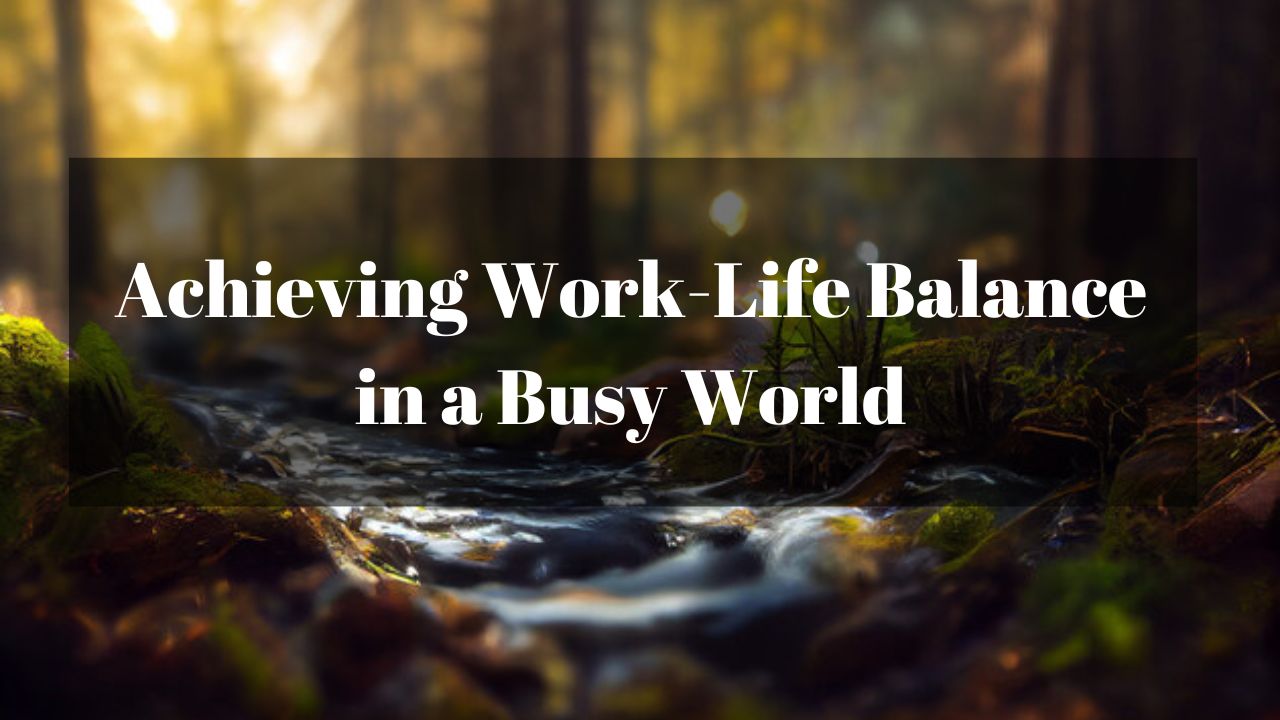Achieving Work-Life Balance in a Busy World
In today’s fast-paced and demanding world, achieving a harmonious balance between work and personal life is an ongoing challenge for many. The constant juggling act can lead to stress, burnout, and a diminished quality of life. In this article, we’ll explore strategies to attain a healthy work-life balance, promoting overall well-being and fulfillment in both professional and personal spheres.
Understanding Work-Life Balance
Work-life balance is a concept that involves striking a harmonious equilibrium between the demands of work and the pursuits of personal life. It is not about dividing time equally between the two but rather about integrating work and life in a way that allows individuals to meet their professional responsibilities while enjoying a fulfilling personal life.
The Importance of Work-Life Balance
A well-maintained work-life balance is vital for several reasons:
Mental and Physical Health:
Chronic stress resulting from an imbalance between work and personal life can have detrimental effects on mental and physical health. It may contribute to anxiety, depression, and various physical ailments. Achieving balance is crucial for overall well-being.
Enhanced Productivity:
Contrary to common belief, overworking does not necessarily lead to increased productivity. Burnout can decrease efficiency and creativity. A balanced lifestyle, on the other hand, fosters increased focus, creativity, and sustained productivity.
Quality Relationships:
Nurturing personal relationships requires time and attention. Maintaining a work-life balance allows individuals to invest in meaningful connections, strengthening their relationships with family and friends.
Personal Growth and Development:
Time away from work provides opportunities for personal growth and skill development. Pursuing hobbies, engaging in learning activities, and spending time on self-improvement contribute to a more well-rounded and fulfilled individual.
Strategies for Achieving Work-Life Balance
Set Boundaries:
Establish clear boundaries between work and personal life. Define specific work hours and resist the temptation to bring work home. Communicate these boundaries to colleagues, family, and friends to create a supportive environment.
Prioritize and Delegate:
Prioritize tasks based on their importance and deadlines. Learn to delegate responsibilities when possible. Effective delegation not only lightens your workload but also allows others to contribute and grow in their roles.
Establish a Routine:
Create a daily or weekly routine that incorporates both work and personal commitments. Having a structured schedule helps manage time efficiently, reducing the likelihood of feeling overwhelmed or scattered.
Learn to Say No:
Recognize your limits and don’t be afraid to decline additional work or social commitments when your plate is full. Saying no is a powerful tool in maintaining a healthy work-life balance.
Utilize Technology Mindfully:
While technology has facilitated flexible work arrangements, it also blurs the boundaries between work and personal life. Set clear guidelines for checking emails and messages outside of work hours to prevent constant connectivity.
Take Breaks:
Incorporate regular breaks into your workday. Short breaks have been shown to enhance focus and productivity. Use this time to step away from your desk, stretch, or engage in a brief mindfulness exercise.
Create a Dedicated Workspace:
If possible, establish a dedicated workspace for your professional activities. Having a designated area helps mentally separate work from home life, even if you work remotely.
Schedule Personal Time:
Treat personal time with the same level of importance as work commitments. Schedule activities that bring you joy and relaxation, whether it’s spending time with family, pursuing hobbies, or simply enjoying moments of solitude.
Practice Self-Care:
Prioritize self-care activities that contribute to your physical and mental well-being. This can include exercise, adequate sleep, healthy nutrition, and activities that bring you joy and relaxation.
Regularly Reevaluate Priorities:
Life is dynamic, and priorities can shift. Regularly reassess your goals and commitments to ensure they align with your current values and aspirations. Adjust your work and personal life accordingly.
The Role of Employers in Work-Life Balance
Creating a work environment that supports work-life balance is not solely the responsibility of individuals; employers play a crucial role as well. Employers can contribute to a balanced workplace by:
Offering Flexible Work Arrangements:
Providing options such as flexible hours, remote work, and compressed workweeks allows employees to tailor their schedules to better suit their personal lives.
Encouraging Time Off:
Encourage employees to use their vacation days and personal time. Create a culture that values and supports taking breaks to recharge.
Promoting Open Communication:
Foster an open dialogue between employees and management regarding workload, expectations, and potential challenges. This transparency helps in finding collaborative solutions.
Providing Employee Assistance Programs (EAPs):
Offer EAPs that provide resources and support for mental health, stress management, and work-life balance. These programs can include counseling services, workshops, and educational resources.
Leading by Example:
Leadership sets the tone for the organizational culture. When leaders prioritize work-life balance, it sends a powerful message to employees that well-being is valued.
The Impact of pandemic on Work-Life Balance
The pandemic has brought about significant changes in the way people work, with remote work becoming more prevalent. While remote work offers flexibility, it also blurs the boundaries between professional and personal life. It is essential for individuals and organizations to adapt and establish strategies that ensure a healthy work-life balance in this evolving landscape.
Conclusion
Achieving work-life balance is a dynamic and ongoing process that requires intention, self-awareness, and proactive strategies. By setting boundaries, prioritizing, and incorporating mindful practices, individuals can navigate the complexities of a busy world while maintaining their well-being. Employers also play a pivotal role in creating a supportive work environment that recognizes the importance of work-life balance. Ultimately, finding harmony between professional and personal pursuits is a key factor in leading a fulfilling and meaningful life.
Thanks for visiting Respect Lifestyle











